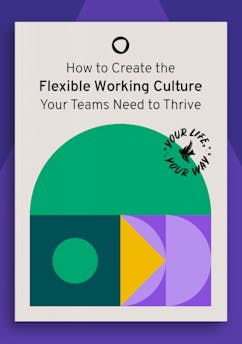Your Life, Your Way—How to Create the Flexible Working Culture Your Teams Need to Thrive
Remember high school? Every morning at exactly the same time, you sat in the classroom with your classmates, back straight, feet under the table. What did all have in common with the student next to you? You were there to learn.
But here’s something that’s often overlooked: while some students are wide awake and receptive at 9am, others are still half-asleep, and might not feel fully operational until midday. And while some blossom in the shared physical environment of the classroom and love the stimulation of the group dynamics, others prefer to read through the textbook chapter at home in the evening in order to truly grasp the subject.
So, we all have different learning habits and preferences. But here’s something we often forget: it's exactly the same in our working lives.
As different as we all are, so are the conditions under which we can optimally absorb new information and convert it into performance.
Here’s the good news: while schools offer little individual flexibility to young learners, the rules by which we learn and work in our jobs are not set in stone. We can change these rules to create a working culture based on autonomy, genuine engagement, and self-directed career development.
In other words, we can give people the flexibility they need to thrive. All it takes is the right blueprint.
Looking for a roadmap to implementing a flexible work culture? Download our strategic cheat sheet and learn how you can overcome the seven most common objections to building flexible work solutions.

So, you want to build a flexible working culture?
By providing your contact info, you agree to receive communications from 360Learning. You can opt-out at any time. For details, refer to our Privacy Policy.
The world of work has changed–for good
The COVID-19 pandemic has disrupted working conditions for hundreds of thousands of companies around the world. And yet, this disruption gave us a unique opportunity to test some new theories of work. What happens to individual and company performance when we’re no longer spending 9am-5pm together in the office, backs straight, feet still under the table? What if one person decides to do deep work late at night at his kitchen table, while the next person works at dawn between two yoga flows?
A study evaluating some 100 million data points from 30,000 U.S. employees during March and April of 2020 showed a work productivity increase of 47%, despite–or because of–the increase in the number of people working from home. In another study, 44.9% of employees report being more productive in a remote working model.
However, a truly flexible working culture is about more than just discussing remote or hybrid working models. It is about disrupting our traditional understanding of work. We do, of course, expect our employees to perform. But instead of subjecting them to time and space constraints to ensure they do their work according to our expectations, we can empower them to determine how they perform best according to their own needs and constraints.
A truly flexible working culture is about more than just discussing remote or hybrid working models. It is about disrupting our traditional understanding of work.
It’s only natural for some readers to feel uncomfortable with this idea. After all, if everyone is given the flexibility to decide how, when, and where they want to work, then how can we truly measure productivity from one person to the next? And what happens to company culture when people no longer have to work side-by-side at the same time?
These are all valid questions. But once we address these concerns and prove the significant benefits of flexible and trust-based learning and working, we can start building a new working culture by sourcing, choosing and implementing the right processes, tools and systems to make it work.
Here’s why it pays to commit to a flexible working culture.
Why it pays to empower your employees to work and learn with full autonomy
If you're reading this playbook, you already know that flexible working is no longer a nice-to-have, or a fanciful Millennial idea. In times of skills and talent shortages, the shift to a working culture that gives employees full autonomy over their work and development is a strategic step into the future of every business.
Studies show that employee satisfaction is higher under flexible working conditions. Happy employees, in turn, are more engaged, more productive, and more likely to remain loyal to their company.
Self-management also pays off in learning and development: According to our recent study, employees benefit from more effective learning experiences when they can flexibly integrate training into their individual workflow instead of following prescribed deadlines.
So that’s the theory. While there’s no shortage of articles and research data that highlight the benefits of flexible working, there doesn’t appear to be much guidance on how to actually implement flexibility in the new world of work. So, let us give you some reassurance: at 360Learning, we took the bet. Today we stand for a unique working culture—Convexity. Aside from being a framework organizations can use to instill a flexible work culture, Convexity is also the number one reason employees choose us.
We're offering a practical guide based on our proven methods and tools to help you develop your own flexible work culture in your company–step by step.
In this guide, we’ll show you exactly how to make remote, asynchronous, and autonomous work a reality. We’ll also show you why self-directed learning drives better development outcomes, and lift the lid on the best tools in the market to support radical flexibility. We’ll even take you on a tour through the biggest roadblocks companies experience when shifting to a flexible work culture–and what you can do to overcome these.
Ready to lift the anchor and set sail? Let’s go.
Let's start the journey.
Next chapter: Remote work.


